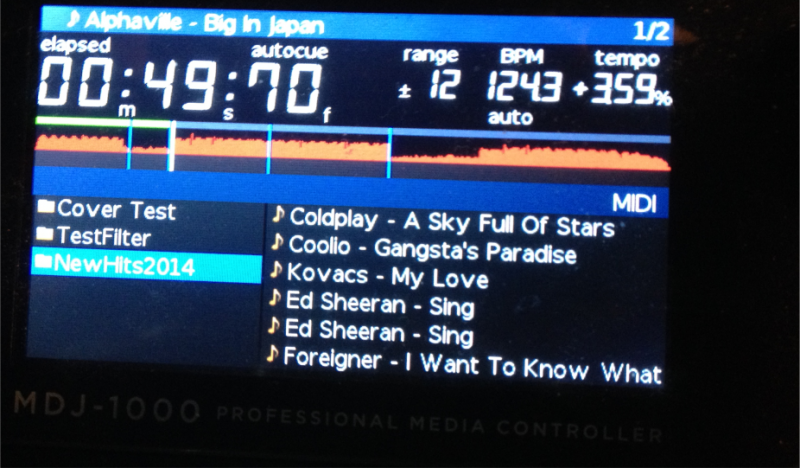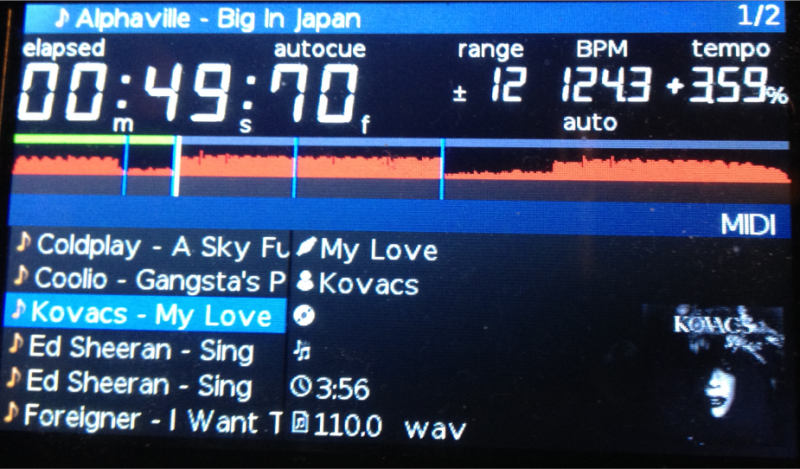GEMINI MDJ-500/600
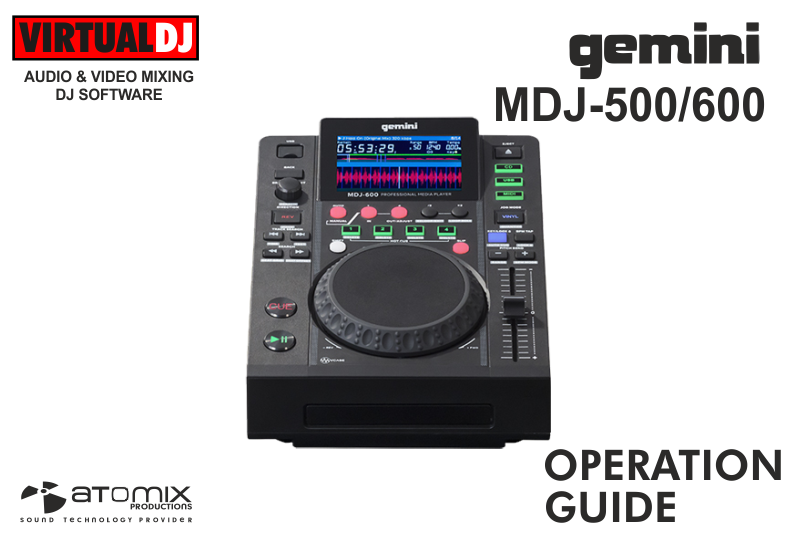
SETUP
Use a pair of RCA cables to connect each MDJ-500/600 Line Output with an Input Channel of a mixer. Any analogue or digital mixer can be used.
Connect your amplifier or amplified speakers to the Master Output of a mixer
Use the provided AC/DC power adapters and power on each MDJ-500/600 your mixer and your amplifier.
Set the MDJ-500/600 to MIDI mode using the MIDI Source Select button (M).

Firmware & Drivers
Firmware
Update the firmware of the unit to the latest version, following instructions provided at:
MDJ-500 : http://geminisound.com/product/mdj-500 (Downloads tab)
MDJ-600 : http://geminisound.com/product/mdj-600 (Downloads tab)
Drivers
Windows: Download and install the latest ASIO drivers from
MDJ-500 : http://geminisound.com/product/mdj-500 (Downloads tab)
MDJ-600 : http://geminisound.com/product/mdj-600 (Downloads tab)
Mac OSX. No drivers are necessary to install for Mac computers. The Operating system will use its own audio drivers when the unit is connected to the USB port.
VirtualDJ 8 Setup
Once VirtualDJ 8 is launched for the first time, a Login Window will appear. Login with your virtualdj.com account credentials.
A Pro Infinity, a PLUS, or a Pro Subscription License is required to use the Gemini MDJ-500/600. Without any of the above Licenses, the controller will operate for 10 minutes each time you restart VirtualDJ 8.
http://www.virtualdj.com/buy/index.html

If you have followed the proposed connections as above, click on the Use Soundcard button.
Click OK

The unit is now ready to operate.
Advanced Setup
MIDI Operation
The unit should be visible in the CONTROLLERS tab of Config and the “factory default” available/selected from the Mappings drop-down list.
The factory default Mapping offers the functions described in this Manual, however those can be adjusted to your needs via VDJ Script actions.
A Pro Infinity, a PLUS or a Subscription license is required to customize the mapping of the MDJ-500/600 (the CONTROLLERS tab will not be available in LE mode).
Note. Each MDJ-500/600 unit (if more than 1 is connected) will be additionally displayed in this window, and any modifications in the mapping file will affect all units.
Find more details at http://www.virtualdj.com/wiki/VDJ8script.html

AUDIO Setup
The unit has a pre-defined Audio setup and a special button in the AUDIO tab of Config to provide that. Alternative Audio setups can be applied in the same window in case a different sound card other than the built-in of the MDJ-500/600 needs to be used.
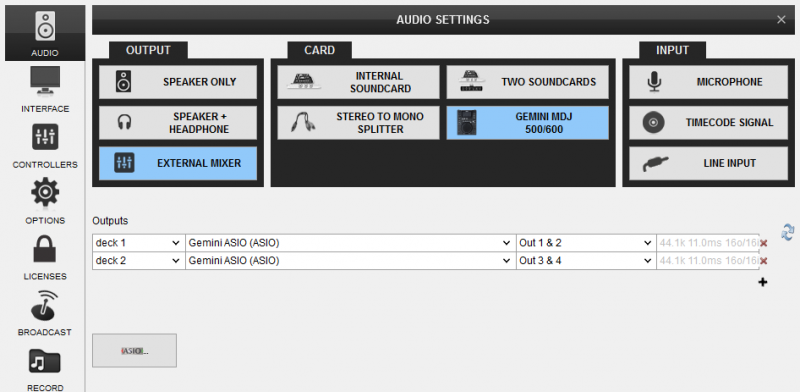
For further VirtualDJ settings and features please refer to the User Guide of VirtualDJ 8.
http://www.virtualdj.com/manuals/virtualdj8/index.html
CONTROLS

- POWER ON/OFF Power on the unit when all audio connections are made.
- POWER. Connect the unit to a Power Outlet using the provided AC cable.
- USB. This USB connection sends and receives audio and control information from a connected computer.
- AUDIO OUT: Use standard RCA cables to connect this output to an Input Channel of an Audio mixer.

- S SHIFT. Hold this button down to access secondary functions of the MDJ-500/600 (mainly in gray boxes)
M MODE. Use these buttons to select the Input Source. Press the MIDI button to allow the unit to control VirtualDJ software or any other MIDI application.
Note that the sound output of VirtualDJ will be muted when switched from MIDI to any other Source.
The MDJ-600 model offers a CD mode button instead of the SETTINGS button on the MDJ-500.
D LCD. The LCD screen of the MDJ-500/600 displays track's info, scratch waveform and Browser navigation. See LCD Screen for details.
- PLAY. Plays / Pauses the track.
- CUE. When the Deck is paused, you can set a Cue Point by moving the Platter to place the Audio Pointer at the desired location and then pressing the Cue Button.
During playback, you can press the Cue Button to return the track to this Cue Point. (If you did not set a Cue Point, then it will return to the beginning of the track.).
If the Deck is paused, you can press and hold the Cue Button to play the track from the Temporary Cue Point. Releasing the Cue Button will return the track to the temporary Cue Point and pause it. - JOG. 8” touch-sensitive high-resolution jog wheel with LCD display for scratching or bending (depending on the VINYL mode selection). The Jogwheel also offers Loop In and Loop Out point adjustment (see Loop Controls)
- SEARCH <<. Hold this button down to fast seek backwards through the track's time in 4 beats steps.
Hold SHIFT down and then use this button to show/hide the Beat-Grid lines on the track's scratch wave. - SEARCH >>. Hold this button down to fast seek forward through the track's time in 4 beats steps
- TRACK SEARCH<<. Use this button to stop the loaded track at its beginning. If stopped at the beginning, load the previous track from the Browser to this deck.
Hold SHIFT down and then use this button to toggle Time display on the MDJ screen between Elapsed and Remain - TRACK SEARCH>>. Use this button to load the next track from the Browser to this deck.
Hold SHIFT down and then use this button to cycle the loaded track's info line on the MDJ display through, Artist-Title, Artist, Title, Album and Genre. - REVERSE. Use this button to play the track in reverse. Once disabled, the track will continue to play at the normal direction from the current position. If Slip mode is enabled, the track will return to the position it would have been if the reverse was never used.
Hold SHIFT down and then use this button to select one of the three available zoom levels for the scratch wave on the MDJ screen. - BROWSE/SELECT. Use this encoder to scroll through files or folders (depending on the focused Browser window)
If focus is on the Songs list, push the encoder to load the selected track from the Browser to the deck. If focus is on the Folders list, push the encoder to set focus to the Songs list.
Hold SHIFT down and then push the encoder to view all the Loaded Track’s Info and Album Art. - BACK. Press this button to set focus to Folders list. If focus is on the folders list, use this button to expand/collapse subfolders.
- EJECT. Use this button to assign this unit to a different VirtualDJ deck. If only 1 MDJ-500/600 unit is connected, the button will cycle though all the available decks (depending on the used VirtualDJ skin). If 2 MDJ-500/600 are connected, the left unit may cycle through the left decks (1 and 3) and the right unit though the Right decks (2 and 4).
Both the assigned deck number and the total number of the available software decks are visible on the LCD screen of the MDJ-500/600 - VINYL. Press this button to set the Jogwheel to Vinyl (Scratch) or CD (Bend) mode. In Vinyl mode, use the outer part of the Jogwheel to bend (temporary speed up – slow down the tempo of the track).
Hold SHIFT and then use this button to enable/disable quantize mode for Hotcues and Loops (will snap to the nearest beat when enabled) - KEYLOCK. Press this button to "lock" the track's pitch to its original key. The track's tempo will remain at the speed designated by the Pitch Fader
Hold SHIFT down and then use this button to enable/disable Autocue mode. If enabled, tracks will load at the 1st Hotcue if available. - BPM TAP/LOCK. Tap this button (for at least 4 times) based on the rhythm of the track to manually adjust the tempo of the track (if incorrectly calculated by the software). When track is paused, tap this button once to move the Beatgrid anchor to the current position.
Hold SHIFT down and then use this button to lock the software Pitch faders of all the available decks so that they move all together if any of them is moved. - PITCH BEND-. Press and hold down this button to temporary slow down the song while pressed. When released, the track playback will return to the speed designated by the Pitch Fader.
Hold SHIFT down and then use this button to select the next available range for the Pitch. The selected pitch range value is displayed on the LCD screen. - PITCH BEND+. Press and hold down this button to temporary speed up the song while pressed. When released, the track playback will return to the speed designated by the Pitch Fader.
Hold SHIFT down and then use this button to match BPM and synchronize Beat-phase of the track with the ones of the track loaded to the opposite deck (or the Master Deck, if more than 2 decks are used) - PITCH. Adjust the track's playback speed (tempo). The pitch value in % and the current tempo value (BPM) are displayed on the LCD screen
Note. The actual pitch fader will not alter the pitch of the track if the actual pitch and the software pitch value do not match (software soft-takeover, ghost fader visible on the GUI). In most cases this may happen if SYNC is prior pressed. - SLIP. Use this button to enable/disable Slip mode. When Slip mode is active, several operations (such as Scratching, HotCues, Loop, pause etc.) will be applied temporary and the track will resume to the position it would have been if the operation was never triggered.
Hold SHIFT down and then use this button to enable/disable Jog Search mode. When enabled (LED blinks fast), use the Jogwheel to fast seek through track's time. - HOTCUES. Each one of the 4 numbered buttons assigns a Hot Cue Point (1 to 4) or returns the track to that Hot Cue Point.
When a Hot Cue Button is unlit, you can assign a Hot Cue Point by pressing it at the desired point in your track. Once it is assigned, the Hot Cue Button will light. To return to that Hot Cue Point, simply press it.
Hold SHIFT down and then press a button to delete its assigned HotCue.
Loops
The Loop section of the MDJ-500/600 offers 2 modes. Use the AUTO/MANUAL button to toggle between the Manual mode (LED on) and the Auto Loop mode (LED off).
Auto Loop mode
- AUTO/MANUAL. Press this button to set the Loop section to Auto Loop mode (default mode), if not already. The LED of this button should be turned off.
When a Loop is enabled (LED will blink), use this button to exit the loop. - 1/IN. Use this button to enable a loop of 1 beat. Use the same button to disable it.
When Loop Roll mode is enabled (LED on) this button will trigger a Loop Roll of 1 beat while pressed and when released, the track will return to the position it would have been if the loop was never triggered. - 4/OUT. Use this button to enable a loop of 4 beats. Use the same button to disable it.
When Loop Roll mode is enabled (LED on) this button will trigger a Loop Roll of 4 beats while pressed and when released, the track will return to the position it would have been if the loop was never triggered. - /2. Use this button to half the size of the loop
Hold SHIFT down and then use this button to jump and enable the last triggered loop (reloop). Use the same button to exit the loop. - X2. Use this button to double the size of the loop
Hold SHIFT down and then use this button to enable/disable Loop Roll mode. When enabled the LEDs of the 1/IN and 4/OUT buttons will be turned on and will trigger a Loop Roll of 1 and 4 beats when pressed.
Manual Loop mode
- AUTO/MANUAL. Press this button to set the Loop section to Manual Loop mode, if not already. The LED of this button should be turned on.
When a Loop is enabled (LED will blink), use this button to to exit the loop. - 1/IN.Use this button to set a Loop In (Entry) point of a manual loop.
If a Loop is enabled press this button to set the Jogwheel to Loop In mode and then use the jogwheel to fine adjust the Entry point of the triggered Loop. The Led will blink to indicate the selected mode. Press again to return the Jogwheel to Jog mode. - 4/OUT. Use this button to set a Loop Out (Exit) point of a manual loop.
If a Loop is enabled press this button to set the Jogwheel to Loop Out mode and then use the jogwheel to fine adjust the Exit point of the triggered Loop. The Led will blink to indicate the selected mode. Press again to return the Jogwheel to Jog mode. - /2. Use this button to half the size of the loop
Hold SHIFT down and then use this button to jump and enable the last triggered loop (reloop). Use the same button to exit the loop. - X2. Use this button to double the size of the loop
Hold SHIFT down and then use this button to enable/disable Loop Roll mode. When enabled once the manual loop is disabled (using the AUTO/MANUAL button), the track will return to the position it would have been if the loop was never triggered.
LCD Screen
Deck’s Info view
By default the LCD screen of the MDJ-500/600 will display all the necessary information for mixing, such as Tempo, Pitch, Track’s Info, Elapsed and Remain Time, along with a detailed scratch-wave and a song progress-wave bar.
The Waveforms will also offer HotCue displays and will have different color for the looped part of the track and the part that will be skipped once Slip is disabled.
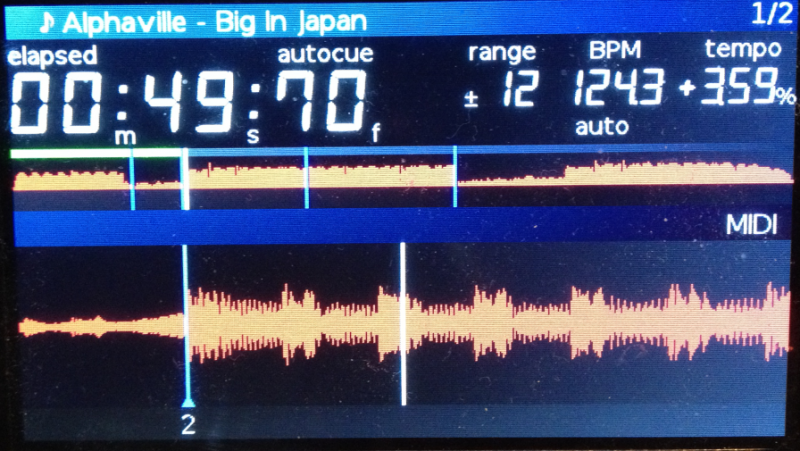
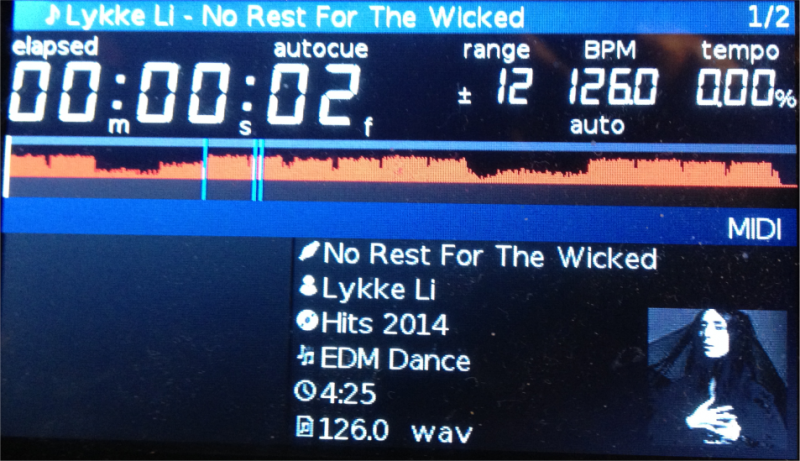
Browser view
The Browser view will be automatically displayed once the BROWSE/SELECT encoder is used and will remain on sight for about 5 more seconds if the encoder is not used.
When the Folders list is focused, the left side will provide the list of the Folders and the right side will provide the content on the focused folder. (Folders view)
When the Songs list is focused, the left side will provide the Tracks list and the right side will provide the Info of the focused track. (Files view)
In the Files view, the track that is currently loaded to the deck, will be colored in red. All other tracks will be colored in white. Due to firmware limitation, no other track coloring behavior is offered.
